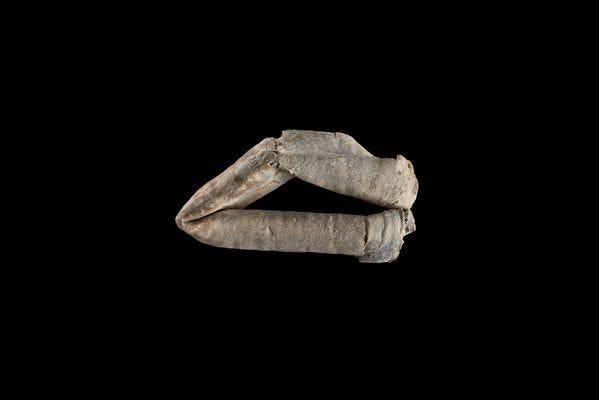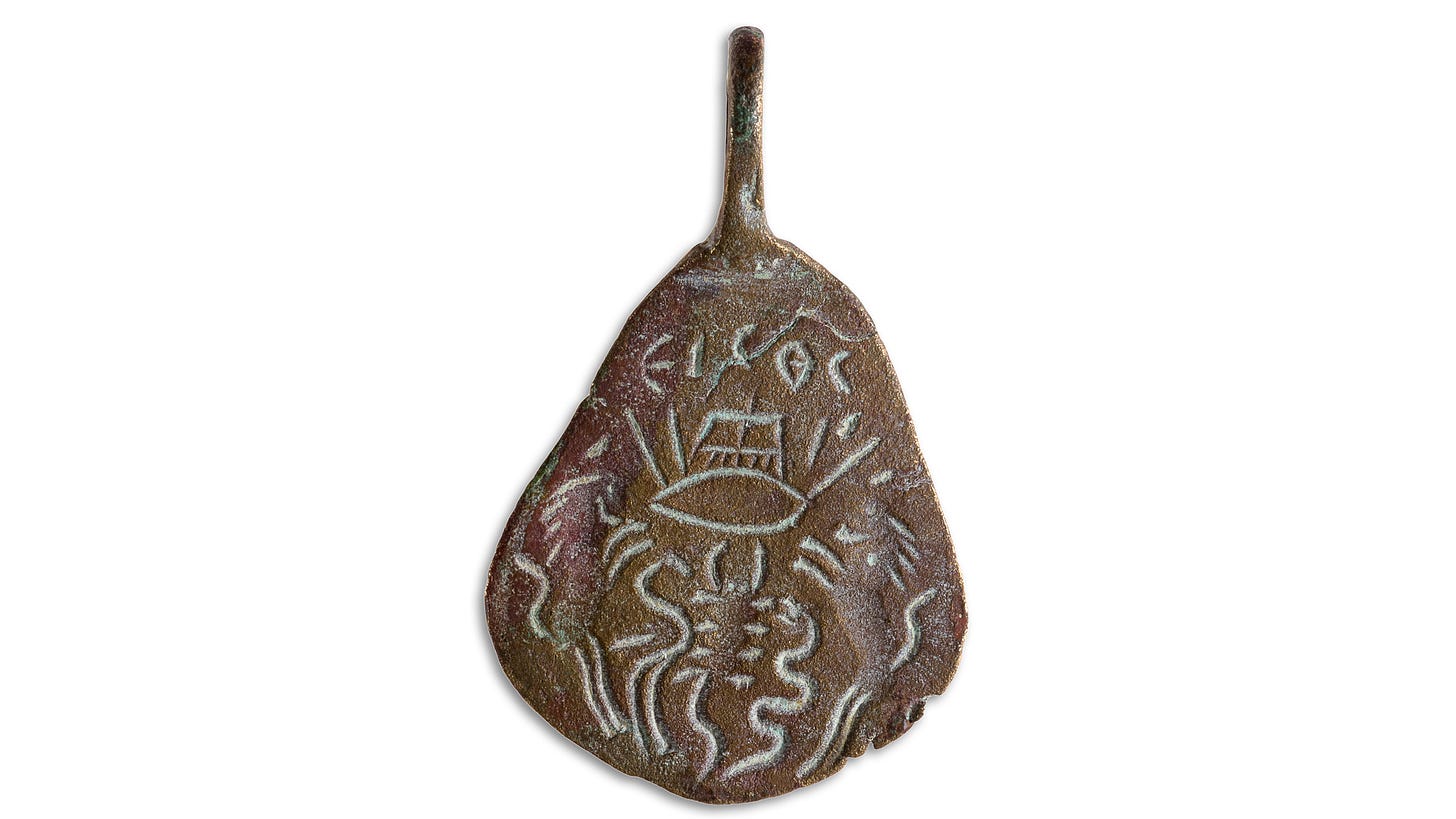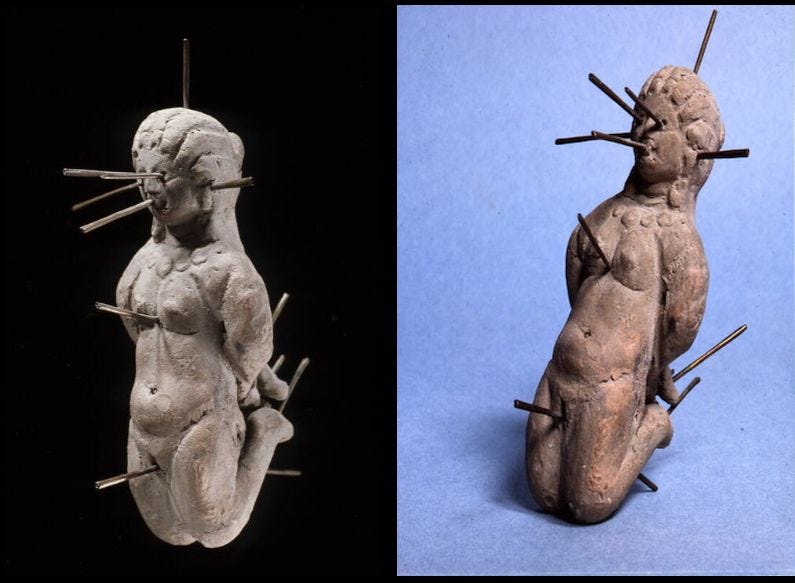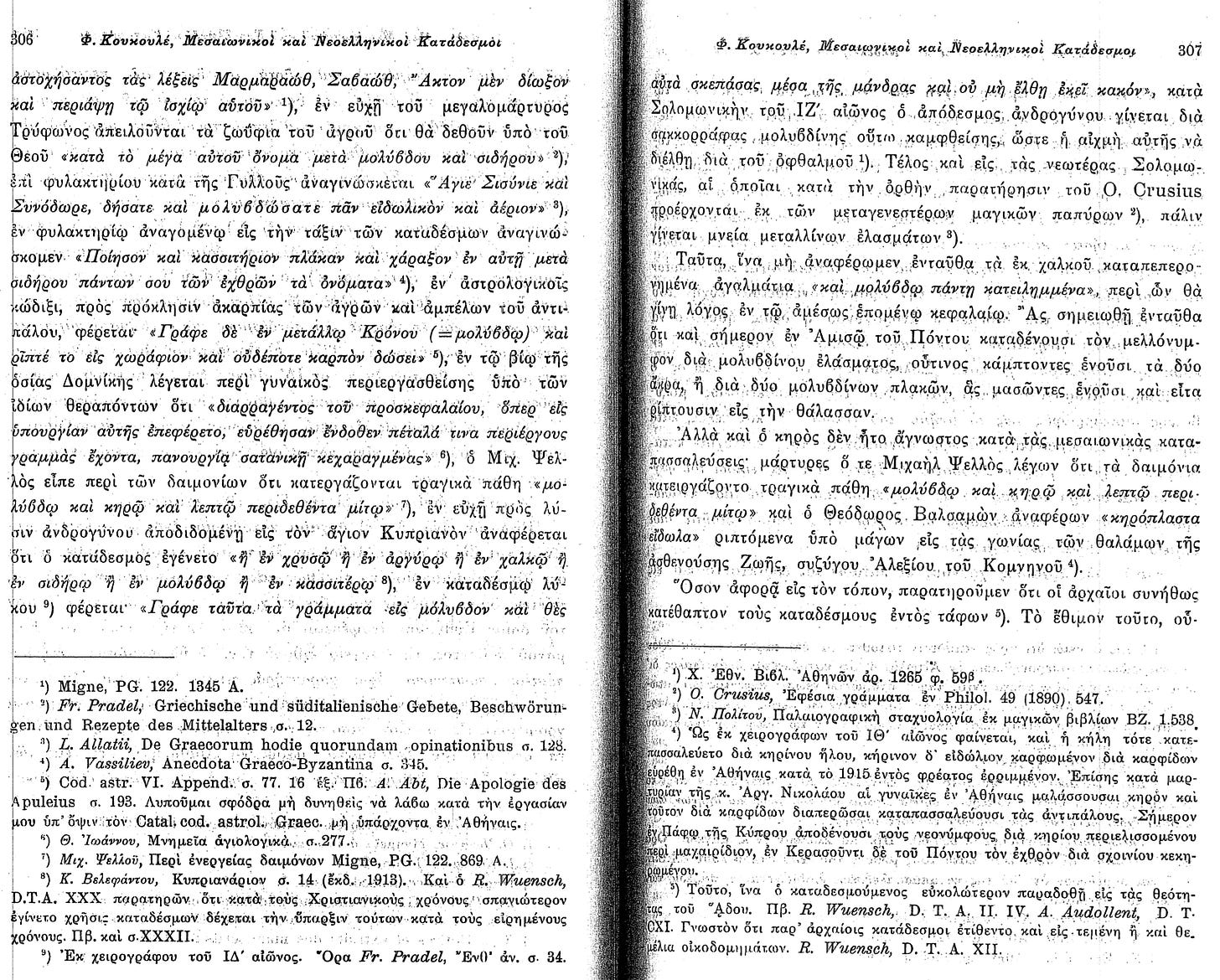How to Hex Like a Byzantine – Part 1
Popular religion, curses, and binding spells from the Byzantine Empire to the 21st Century (with FAQ)
Please note that as a long read, not all of this post will show up in your inbox. Just click on the “read more” link at the bottom to see the full post, or click here to view the full post in your browser.
For centuries, Greek villagers, mystics, and even monks buried secrets in the earth—scratched into lead, whispered into wax, or hidden beneath thresholds and graves. These were κατάδεσμοι— binding spells or curse tablets. Born in the shadow of ancient Hellenic rites and persisting in the Orthodox Christian world, these invocations aimed to bind enemies, win love, silence rivals, or deliver justice where law failed.
Across medieval and modern Greece, this tradition persists far longer than most people realise. Far from being a curiosity lost to antiquity, these spells adapted, survived, and flourished in Christian, Ottoman, and modern Greek contexts.
Whether scratched on thin lead sheets, moulded in wax or soap, engraved in tin or copper, inscribed on pottery shards, sewn on felt or written on paper, the intent was always the same: to affect the body, mind, or fate of another through supernatural means.
The translation that follows below is from a detailed ethnographic study covering 17 centuries, from the 3rd to the 20th, with sources ranging from Byzantine law and sermons to hagiography and folk custom.
But first, a FAQ.
What are katadesmoi?
A katadesmos was typically a small inscribed tablet—often made of lead in the past; though even paper will do—buried in a grave, well, or other hidden spot. Today it might be buried or burned. Sometimes it was a wax effigy, or a thread binding a nail to a simulacrum, or even a written formula sewn into a pillow or cast into the sea. The words on these tablets called upon spiritual forces to “bind” an enemy: to silence their voice, weaken their limbs, cloud their thoughts, break or bind their marriage. Sometimes the spell targeted the head to seed madness, the heart to destroy love, or the limbs to cause paralysis.
But the Church stamped out pagan practices, didn’t it?
Officially the Church and Byzantine state authorities condemned these acts as sorcery, threatening excommunication for anyone who practiced or even consulted such magic.
Yet, canons, and sermons reveal that people across the Greek world kept using and fearing binding spells, from the villages to the imperial sickrooms. They were used by officials and royalty alike for military victory or to destroy rival kings.
From the 4th through the 15th centuries and well into the modern era, ordinary people, priests, saints, and even emperors grappled with - and sometimes used wax images, lead tablets, and enchanted objects hidden in homes, fields, or under doorsteps and beds. Several empresses are attested as openly dabbling in divination and magical practices.

The translation below documents their trajectory - and remarkable stability- into the twentieth century. As to the twenty-first - nearly everyone I know is familiar with the practices, and many, myself included, have seen or at least heard about them being practiced to this very day.
But they’re just old superstitions
No. Binding spells were used in love affairs, legal disputes, military campaigns, for protection against thieves, disease, weather, or wild animals, to punish rivals and to find lost objects. The same basic formulas and ritual gestures reappear from ancient Athens to medieval Thessaloniki and Ottoman Epirus.
Even when the names of saints replaced those of ancient gods, the structure and logic of these spells did not change, as we see in other translations I have shared here.

The very fact that many such accounts are preserved in the Lives of Saints suggests they were considered educational; more importantly, their power was believed by the laity and clergy alike; otherwise there would not have been such strong exorcisms against them, nor reversal practices explicitly designed to break such spells.
Many spells were preserved and transmitted in folk grimoires, a few of which remain in wide circulation in cheap paperbacks. These include a wide range of spells; mostly for protection and healing, but a substantial number that are also intended to bind or harm. Others are passed down in families, either as iatrosofika (manuals of folk medicine incorporating spells) or orally, from mother to daughter (and sometimes mother to son).
Again, I personally know of several such cases; much as we joke about it, these are not limited to the quaint old ladies in Greek villages. At least a handful of these spells are commonplace, and some people know- and use-a great deal more. These are ordinary, everyday people, who don’t all necessarily even think of it as “magic” or “esoteric;” many would call it “tradition.” But magic it unarguably is, material manipulation, directed intention, incantations, and all.
So they’re a mishmash of Western magic and half-remembered old-wives’ tales?
Again, no. Many spells I’ve encountered and found in the circulating grimoires are the same as those in these documented examples, with recognisable elements deriving straight from the PGM and Testament of Solomon. Some also draw directly on Dioscorides’ herbal lore, others are clearly clever ways to activate a self-healing process.

There are sometimes small changes, but overall they are the same practices, though in some regions certain variants will predominate. For example, in farming regions, there are blessings or spells to ensure the health of livestock (or curse those of a rival); in cities love, money, or legal spells may predominate.
Those against disease, and the evil eye, are ubiquitous, and formally acknowledged by the Church as well. In some cases such rituals are performed by priests or monks, in others by laypeople “in the know,” but they are remarkably similar across regions.
In cases of illness, an “evil eye” scan (with a special incantation and ritual), followed by its exorcism, is performed even among the most progressive modern population, even if modern biomedicine is also applied. Just in case…
Who used them—and how?
Records show women and men alike were accused of deploying such spells—sometimes to win love, sometimes to cause illness or madness, sometimes to silence a witness or sway a judge. The act might involve burying a wax figure pierced with pins, or writing the victim’s name and a formulaic curse and sealing it under a doorstep. Folk prayers and even Christian exorcisms sometimes borrowed this same “binding” language.

What did the curses actually say?
Typical formulas included:
Let his tongue be silenced, his heart be broken, his limbs fail.”
May her voice falter, may her words turn to dust.”
“I bind you, your breath, your mind, your sleep.”
Koukoules records nearly identical wording from Byzantine and later folk sources. In some cases, the spell was placed in a grave, or nailed to a tree, or even cast into the sea to keep it hidden and unbreakable.
How did people respond?
Historically the Church thundered against these acts, and many sought counter-curses or protection from saints. Yet the surviving legal, theological, and folk records show that such practices remained a daily reality for many. They were both feared and—when all else failed— relied upon even by clergy, as openly admitted in one testimony below.
The Church’s current stance is that blessings and exorcisms are permitted to break spells, but it is forbidden to perform anything that binds or harms. Incense to support “release” spells is made and sold by monasteries and one may ask a priest to assist if need be. Several official exorcisms (which barely differ from such spells) are written into the official prayer books.
But didn’t they burn people at the stake for things like this?
No. That would be the Catholics and Protestants. As a rule, the most common penalty for sorcery was temporary excommunication (evidence below). Those actually perpetrating it were often claimed to have died as a result of breaking their spells, hence a form of divine justice was administered, as seen in the accounts that follow.
In Orthodox Byzantium, capital punishment and occasionally, amputation (usually of the nose or tongue) were occasionally legislated as punishment against sorcery or impiety. In practice, these were rarely and inconsistently implemented (barely if at all in the provinces). Most commonly, they were applied in cases where an example needed to be set, or in the context of the highly emotionally charged iconoclasm which itself reflected deeper political struggle.
This will have to be the subject of a separate, dedicated piece, but suffice it to say that Koukoules’ other studies are quite detailed on the evidence for this.
It is important for readers from non-Orthodox backgrounds to grasp that the practices and perceptions they are accustomed to hearing about in Western European and American locales did not apply in Byzantium, and indeed, that kind of punishment ran in direct opposition to Orthodox theological canon, according to which metanoia - repentance- is always possible, original sin not accepted, and human free will paramount. This is the key reason why magic to harm was forbidden, but magic to heal was permitted, as is also outlined in the modern Church’s official position on magic:
The main takeaway here is that yes, occasionally strong punishments were imposed, but by the 14th century the worst that would happen was excommunication, punishment enough if one believed in Orthodox soteriology, on which more here and here.
Why does this matter today?
The persistence of katadesmoi is a window into the anxieties, hopes, and everyday struggles of Greek communities across centuries, on which more here. They reveal a world where fate could be bent by words, and the boundaries between magic, religion, and law were constantly negotiated, even with the very heavens. This notion is built right into the wording of the liturgy; one need only listen carefully.
Most of all, this evidence decisively refutes the ongoing narrative that magic died out with Christianity, and that pagan practices were stamped out.
A statue of Athena - believed to be a magical oracle - stood in Constantinople until the fourteenth century. As the translation below reveals, “the people of Constantinople dismembered the statue of Athena", believing that it “had been enchanted on behalf of those from the West, because it faced the West and seemed, with its hand, to beckon the armies coming from that direction.”
Not because it was a depiction of Athena, but because, as in Troy, the gods are fickle.
In short, the power of the old gods was still acknowledged, and their propensity to turn against their people is older than Homer; not a product of Christianity.
In the same period Byzantine Empress Euphrosyne Doukaina Kamatera took to whipping, then amputating parts of statues for the same reason, including the snout of a boar statue, again, hardly a pagan emblem.
The Nomokanones throughout the centuries and into our day regularly lamented such practices, occasionally bishops were ordered to clamp down - which they did through issuing penances, thundering sermons, or witholding communion.
And life went on just as it always had, whereby multiple attestations of these practices are recorded throughout the centuries to this day (though we don’t whip our statues, but do occasionally pull down modern art).
Want to see the real thing?
In this series, I’m beginning the first complete English translation of Phaidon Koukoules’ rare 1921 work, Μεσαιωνικοί και Νεοελληνικοί Κατάδεσμοι (Medieval and Modern Greek Curse Tablets)—a scholarly, detailed exploration of magical practice in Byzantine and post-Byzantine Greece.

This is the first of several instalments, as the full text is around 65 pages long in dense Katharevousa (purist reconstructed Greek) mixed with lengthy excerpts in Greek variants from every century after the 4th, with extensive footnotes (this is why Modern Greek is a valuable language for scholarship… you can’t decipher this if you only read Classical; but you can parse all the registers when you have a formal command of Modern Greek, which is a palimpsest again, not a corruption as some would have it.)
This translation is taking time to prepare as I am working on it alongside other works in progress. I will intersperse the following instalments with other topics already under way.
What you'll find behind the paywall:
Word-for-word translations from the original Greek.
Authentic medieval and modern Greek spells, binding formulas, and narrative accounts from primary sources.
Reports of wax effigies, lead tablets, and incantations from rural Greece to Constantinople.
Church reactions: excommunications, thundering sermons, canonical bans—and the quiet reality of clerical complicity.
The integration and overlap of pagan formulas with Christian exorcisms, resulting in a cultural palimpsest where older and newer rites merged and coexisted.
Welcome to the documented dark magic of Greek history.
🔒 The full translation begins below—available to paying subscribers.




